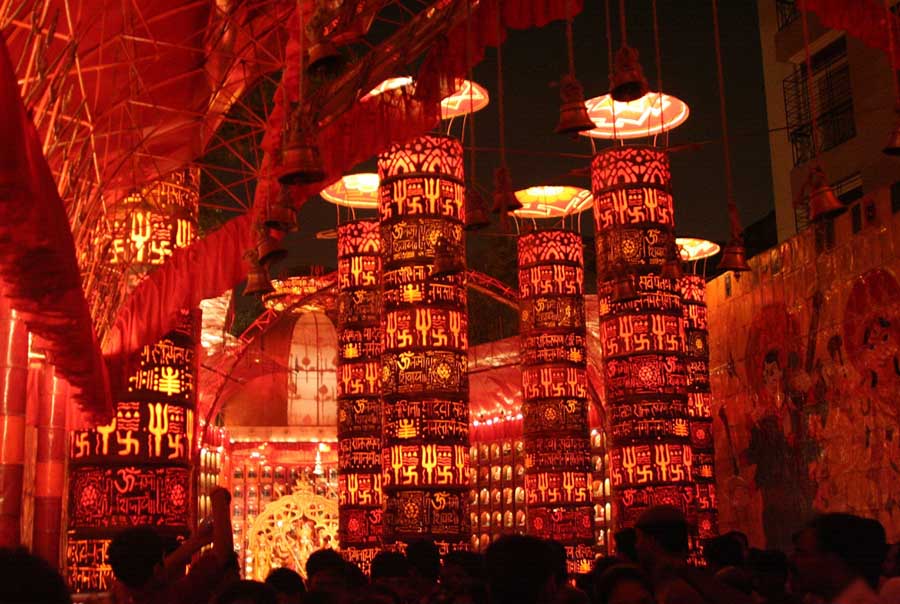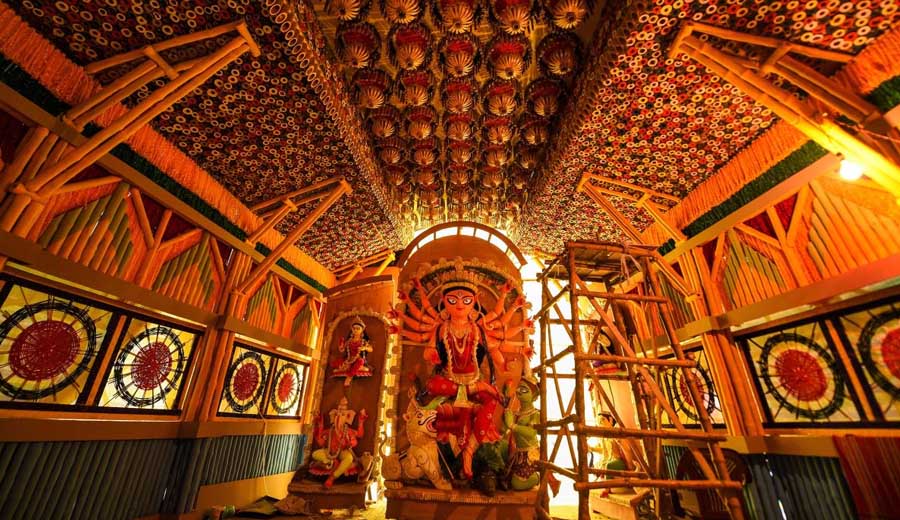Quick research will tell you that the probable first Durga Puja in Kolkata was celebrated in the year 1610. This was at the home of Sabarna Roychowdhury at Barisha, the landowners of Sutanuti, Gobindapur, and Kolkata — the 3 villages that later developed into Kolkata city.
Now, this is the Puja that started about 80 years before Job Charnock set foot in present-day Kolkata, in 1690.
Several years later, in 1757, the first family Durga Puja started in Kolkata, at Sovabazar Rajbari. This was also the year when the last Nawab of Bengal, Siraj-ud-Daullah lost to the British at the Battle of Plassey and India lost its independence.
Running into 261 years, this puja was started by none other than Raja Nabakrishna Deb.
However, the first grand worship of Goddess Durga in recorded history is said to have been celebrated in the late 1500s. Folklores say the landlords, or zamindars, of Dinajpur and Malda initiated the first Durga Puja in Bengal. According to another source, Raja Kangshanarayan of Taherpur or Bhabananda Mazumdar of Nadiya organized the first Sharadiya or Autumn Durga Puja in Bengal in 1606.
Durga Puja was Organized at Rich Men’s Home at That Time
Durga Puja was organized in the homes of the landed gentry, zamindars, and during the early British period, in the homes of the nouveau riche, the wealthy businessmen of Bengal.
Organizing Durga Puja was a costly affair and it was a demonstration of wealth by this class of businessmen who became rich in the early British period.
High-level British officials freely attended these Pujas and these Pujas also acted as opportunities to become close to the British, thereby benefitting financially.
Later, in 1840 a law stopped the British from participating in these Pujas.
Durga Puja was Restricted to a Select Few
Durga Puja in all its grandeur and glory was restricted to a select few. The reason was that it needed substantial financial capacity to organize such a 4-day festival.
For almost the next one hundred and fifty years, it remained restricted within a small circle.
It was only when Barowari Puja took root, Durga Puja became the people’s festival we see today.
It is an interesting tale; let’s know more about it.
The First Barowari Puja at Guptipara
The origin of the community puja can be credited to the twelve friends of Guptipara in Hoogly, West Bengal, who collaborated and collected contributions from local residents to conduct the first community puja called the ‘baro-yaari’ puja, or the ‘twelve-pal’ puja, in 1790.
This Puja was the first instance of community puja.
The baro-yaari puja was brought to Kolkata in 1832 by Raja Harinath of Cossimbazar, who performed the Durga Puja at his ancestral home in Murshidabad.
However, the journey to wider adoption of community Pujas had to wait for almost a century in Kolkata.
Sarbojonin Durgotsav Started
The first Barowari Durga Puja was organized in Kolkata by Bhowanipore Sanatan Dharmotsahini Sabha in 1909 at Balaram Bose Ghat Road, Bhowanipore. On this occasion, Sri Aurobindo published the famous Durga Stotra in his Bengali journal, Dharma, issue one “Kartika” dated 1316 AD.
Other Barowari Durga Puja that followed were the College Street Tamer Lane Sarbojonin Durga Utsav of 1915, Shyampukur Adi Sarbojonin of 1911, Sikdar Bagan (in the Shyambazar neighbourhood) of 1913, Nebubagan, which in 1919 became Bagbazar sarbojonin, Simla Byam Samiti of 1926 and Amherst Street Lohapatty Sarbojonin of 1943, which later became Maniktala Chaltabagan Lohapatty Durga Puja.
“The baro-yaari puja gave way to the sarbajonin or community puja in 1910, when the Sanatan Dharmotsahini Sabha organized the first truly community puja in Baghbazar in Kolkata with full public contribution, public control, and public participation. Now the dominant mode of Bengali Durga Puja is the ‘public’ version,” write M. D. Muthukumaraswamy and Molly Kaushal in Folklore, Public Sphere, and Civil Society.
The Evolution of Pandal and Idol
Traditionally, the idol of the Goddess along with her sons Kartik and Ganesh, and daughters Lakshmi and Saraswati was created in one single structure — ekchala.
There are two kinds of embellishments that are used on clay—sholar saaj and daker saaj. In the former, the pratima is traditionally decorated with the white core of the shola reed which grows within marshlands.
Later on, beaten silver (rangta) was used. The silver used to be imported from Germany and was delivered by post (dak). Hence the name daker saaj.
Initially, huge canopies were built to house the idols and perform puja. Nowadays, the canopies, as called pandals, are built based on different creative themes and beautiful embellishments.
Present Day Spectacular Theme Based Pujas
Over the years, sarbojonin Durga Pujas have become huge spectacles in Kolkata.
With skyrocketing budgets (with massive corporate sponsorships), Pujas have turned into theme-based events.
This has generated massive interest from the general public. They spend hours in the crowded streets of Kolkata and visit different pandals and experience the visual extravaganza.

Apart from the pandals, the idols, and the lighting have a huge transformation to bring out the innate creativity of the artisans.
Although these Pujas offer unique immersive experiences, somehow the simplicity and sincerity of the older day Pujas are missing.
However, residential complex pujas are bringing back old memories with their hearty devotional worship of the Goddess.
The UNESCO Recognition
On December 2021, Durga Puja was inscribed on the UNESCO Representative List of the Intangible Cultural Heritage of Humanity.
Director and UNESCO Representative for the UNESCO New Delhi Office, Eric Falt, had said the inclusion of Durga Puja in the list represents how all stakeholders came together.
“India perhaps offers more intangible cultural heritage practices than any other country in the world. And, many of them are in need of safeguarding. We at UNESCO work closely with the government of India in the preservation of monuments and the intangible cultural heritage, which many times tourists miss or are not much aware about,” he said.
Durga Puja is Now International
When the capital of British India shifted from Kolkata to Delhi in 1911, many Bengalis also migrated to Delhi.
They started Durga Puja in 1910 which is still organized today and is known as Kashmir Gate Durga Puja.
In a similar fashion, the Bengali diaspora organizes Durga Puja in the major cities of India. Puja celebrations in Bangalore or Mumbai can beat any Kolkata Puja in scale and fanfare.

The festival is celebrated in more than 150 places across 36 countries besides India and Bangladesh, on all five continents. In America, Europe, and Africa, Durga Puja was initiated nearly half a century ago. These cities have a sizeable Bengali population and Durga Puja provides them a unique opportunity to come together, share nostalgia, and enjoy the common cultural milieu.
The spirit of Durga Puja, the triumph of the good over the evil, is everlasting.






